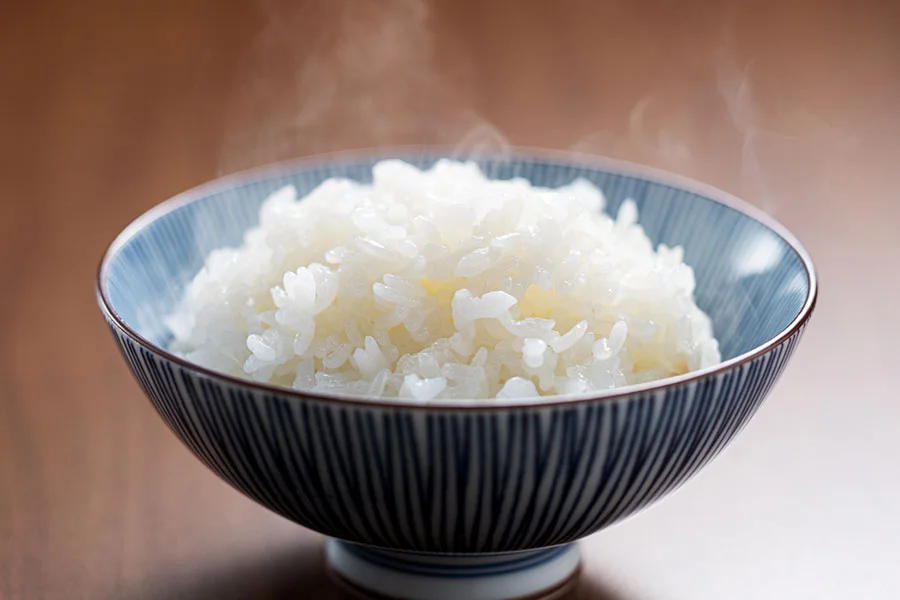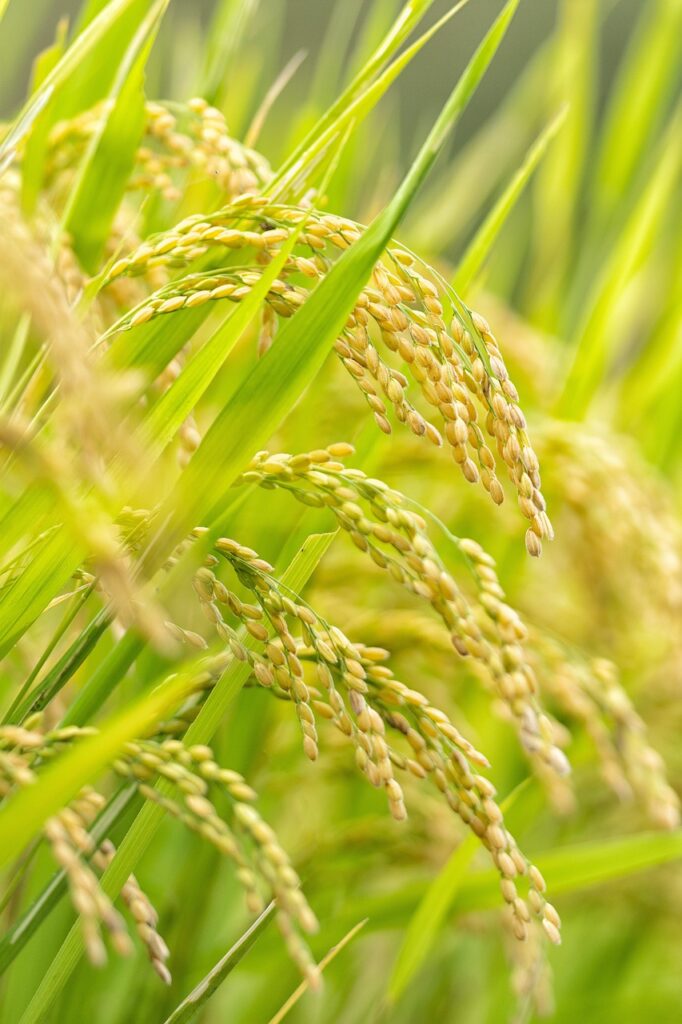Chapter 1: Introduction to Japanese rice
I think there are many people who don’t know about Japanese rice, which is an important meal in Japan, so I would like to introduce it to you.
Japanese rice, often known by names such as Shinmai'' orKoshihikari,” refers to a type or brand of rice unique to Japan. Japanese rice is an essential part of the daily diet for many Japanese people due to its unique flavor, stickiness, and texture. Due to its characteristics, it is an essential part of many dishes unique to Japan, such as sushi, rice balls, and side dishes for rice dishes.
The characteristic stickiness of Japanese rice comes from the high content of amylopectin in the rice grains. Thanks to this amylopectin, Japanese rice hardens easily and has a different texture compared to rice from other countries. This stickiness is especially important when shaping rice balls or using it as sushi rice. Because of its strong stickiness, the rice grains stick together tightly and maintain their beautiful shape without sticking to your hands or the sushi toppings.
Japanese rice is also characterized by its sweetness. This is said to be due to Japan’s cool climate, seasonal changes, and water quality. In particular, Japanese water is rich in minerals, which are said to affect the flavor and quality of rice. This balance of sweetness and stickiness creates the unique deliciousness of Japanese rice.
Japanese rice, which is produced all over Japan, has different features and characteristics depending on the region. For example, there are many brands of rice that reflect the climate, soil, and water quality of each region, such as Koshihikari'' in Niigata,Tsuyahime” in Yamagata, and “Akitakomachi” in Akita. Each of these brands of rice has a unique flavor and texture depending on the climate and environment of the region where it is grown, as well as the skills and passion of the producers.
To conclude, Japanese rice is at the center of Japanese food culture and life. Its unique flavor and texture have made it an essential part of Japan’s diverse cuisine and dining scenes. The presence of Japanese rice, which adorns the Japanese dining table, always appears in new forms in our daily lives and continues to delight our hearts and palates.

Chapter 2: History and background of food
We will tell you how Japanese rice has developed in Japan until now, including history and food.
Since ancient times, the culture of rice cultivation has taken root in Japan, and it is said that rice cultivation began in the Kofun period. During this period, paddy fields were created by hand and rice was cultivated using wetlands and river floodplains. This is said to be the beginning of rice cultivation in Japan.
During the Heian period, rice cultivation techniques evolved and paddy farming began to spread in earnest. It is said that during this period, the prototype of today’s Japanese rice was cultivated. The Heian period was a time when culture and art flourished, and at the same time, food culture also developed. Especially in urban areas, a food culture in which rice is the staple food has spread. From around this time, rice became a central part of the Japanese diet.
After passing through the Middle Ages and entering the Edo period, rice cultivation in Japan achieved further development. During this period, many new rice varieties were developed, and each region began to produce varieties suited to its region. Also, during this period, new water facilities were introduced and rice cultivation techniques were improved, leading to a significant increase in rice production.
Rice came to play an even more central role in the food culture of the Edo period. In urban areas, a new food culture was born, and dishes such as sushi and tempura became popular. These dishes made the most of the characteristics of Japanese rice, and were loved by many people as dishes that allowed you to enjoy the flavor and texture of the rice.
In the modern era, Japan’s rice cultivation technology further evolved. With the introduction of mechanization and chemical fertilizers, large amounts of rice began to be produced. And the Japanese eating culture has also changed. Under the influence of Western culture, new ingredients and dishes such as bread and noodles have appeared. However, in spite of this, the center of the Japanese diet remained unchanged, and the place of rice remained unchanged.
Nowadays, Japanese rice has become even more diverse. A wide variety of rice has appeared on the market to meet consumer needs, including rice grown using organic farming methods and rice specialized in specific varieties. Additionally, as people become more health-conscious, demand for highly nutritious rice, such as brown rice and rice grains, is increasing.
Throughout history, Japanese rice has been at the center of Japanese dietary culture. Behind this is a long history, the evolution of rice cultivation techniques based on that history, and the Japanese people’s love for rice. From now on, Japanese rice will always be mine.

Chapter 3: Modern Japanese rice
We will introduce what Japanese rice is like in modern Japan.
Japanese rice has become an indispensable part of many families’ dining tables even in modern Japanese society. Because of its quality, flavor, and deep ties to food culture, it has become an essential part of many Japanese people’s daily meals.
Recently, as consumers have become more health conscious, rice with various degrees of processing has become popular, including not only white rice but also brown rice, germ rice, and half-white rice such as half-white rice. These rices are rich in vitamins, minerals, and dietary fiber, and are said to be good for health and beauty. In particular, brown rice, also known as ancient rice, has been known as a health food since ancient times.
Additionally, modern Japanese rice has a richer flavor and texture due to improved varieties. New varieties of rice developed uniquely in each region are adapted to the region’s climate and soil, and each has a different flavor and texture. This allows people to enjoy unique flavors all over the country.
Furthermore, in modern Japan, rice production technology has evolved significantly. The use of pesticides and chemical fertilizers has been reduced, and rice grown organically and with reduced pesticide use is increasing. This makes it possible to enjoy safer and more flavorful rice. Additionally, the introduction of IoT technology has enabled precise cultivation management, leading to the production of higher quality rice.
Furthermore, modern Japanese people are creating a new food culture using rice. For example, a variety of dishes and products using rice have appeared, such as on-the-rice dishes, new variations of rice balls, and even sweets and breads made with rice flour. This has given us more opportunities to reaffirm the potential and appeal of rice.
In conclusion, modern Japanese rice is a fusion of traditions and techniques passed down from ancient times with new techniques and ideas, making it even more diverse and rich. I hope that Japanese rice will continue to be enjoyed at Japanese dining tables, as it has many attractive features such as its flavor, texture, and benefits for health and beauty.

Chapter 4: Famous works featuring Japanese rice
We will introduce some famous works that feature Japanese rice.
Japanese rice has been featured in many arts and entertainments because of its history and cultural background. Let’s pick out some of the most noteworthy works and unravel their charm.
First, in the world of movies, there is Akira Kurosawa’s “Seven Samurai.” In this work, the story revolves around a village where farmers are growing rice. In the background of the samurai fighting to protect the village is a landscape of rice ears swaying in the wind during a bumper harvest. Through this work, we can see how much value Japanese rice had and how it supported people’s lives.
Next, in the world of literature, we can mention Kenji Miyazawa’s “Yodaka no Hoshi.” In this story, the main character learns about bonds with people and coexistence with nature through rice harvesting. Through Kenji’s poetic writing style, the scenes of rice fields, rice planting, and harvesting are depicted, conveying the beautiful climate of Japan and the importance of Japanese rice.
In the world of animation, Hayao Miyazaki’s “My Neighbor Totoro” beautifully depicts rural landscapes. Vast rice fields spread out around the house where the main characters live, and the cultivation of Japanese rice is depicted as a part of life, along with the seasonal rural scenery.
Through these works, we can see that Japanese rice is not just a food ingredient, but is deeply connected to Japanese culture, history, and nature. These works based on Japanese rice give us a sense of the deep history and culture behind the Japanese rice that we come into contact with on a daily basis.
Japanese rice, along with its unique flavor and food culture, has inspired many creators. I look forward to seeing how Japanese rice will be depicted in new works and how it will evolve.
Chapter 5: Summary
This is a summary about Japanese rice.
Japanese rice is deeply connected to our lives as it is at the center of Japan’s food culture, history, and lifestyle. Through this series, I hope you were able to reaffirm the charm, background, and value of Japanese rice.
First, by introducing the basic properties and characteristics of Japanese rice, we were able to understand the background of how its unique flavor and texture were formed. I was also able to explore the relationship between Japan’s seasonal features and climate and how they affect the cultivation and characteristics of Japanese rice.
Furthermore, by thinking about its historical background and its connection to food culture, I think I was able to get a sense of the value of Japanese rice and how it has taken root in the lives and hearts of the Japanese people. Even in modern Japan, its value and significance remain unchanged, and it continues to be cherished as an indispensable part of many people’s dining tables and daily lives.
In addition, by examining the treatment of Japanese rice in entertainment and the messages conveyed through various works, we are able to reaffirm the universal appeal of Japanese rice and its deep background. It’s done.
Finally, Japanese rice not only has a place and value in our food culture and history, but also has an impact on our lives and hearts through the hearts and sensibilities of the Japanese people, and their relationship with nature throughout the seasons. It’s deeply rooted. I hope you can gain a new perspective and understanding of Japanese rice by reading this blog.
We sincerely recommend that you continue to cherish Japanese rice and enjoy it in your daily life while feeling its deliciousness and charm with all five senses.
